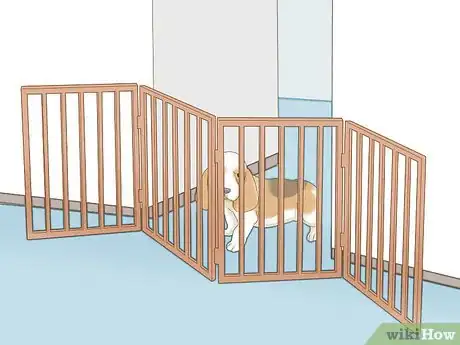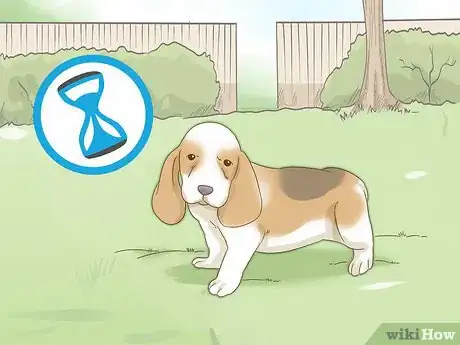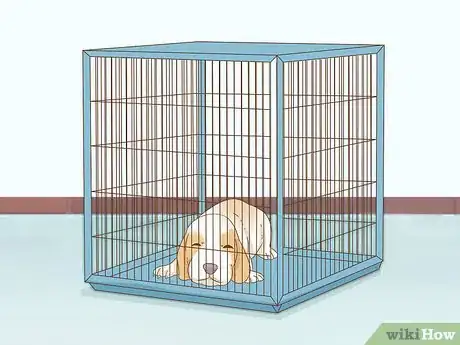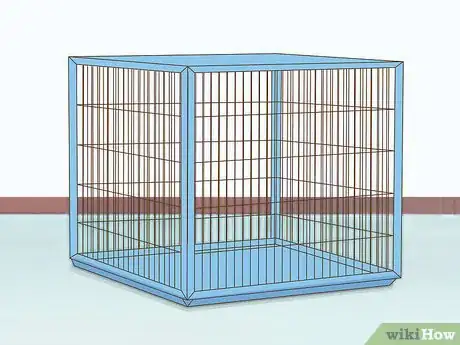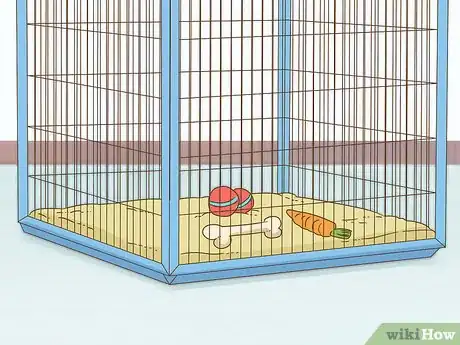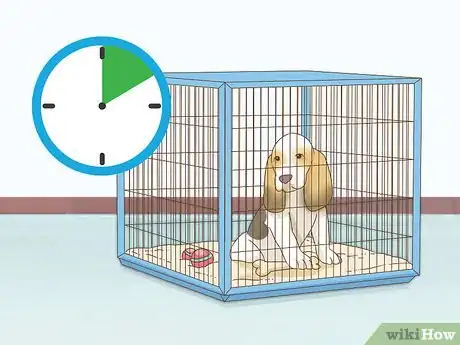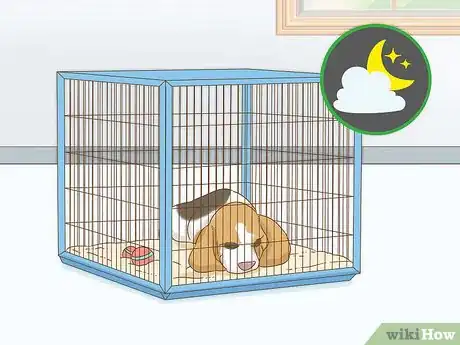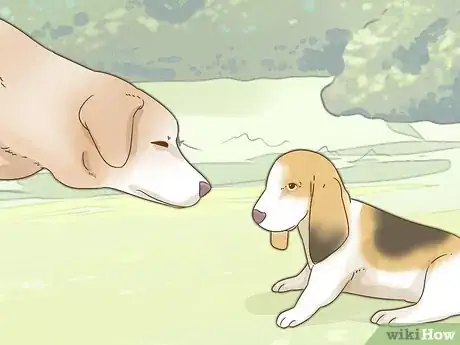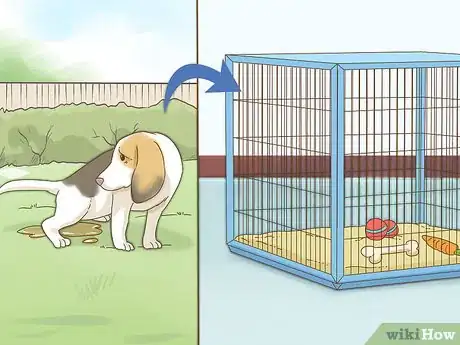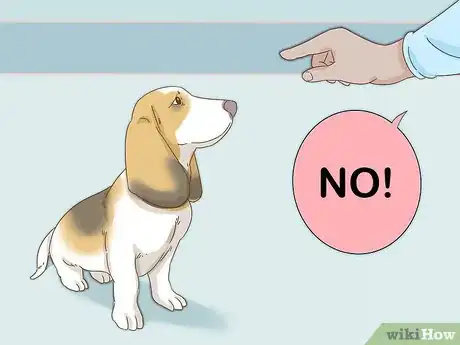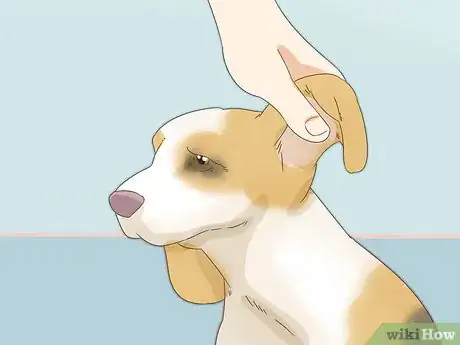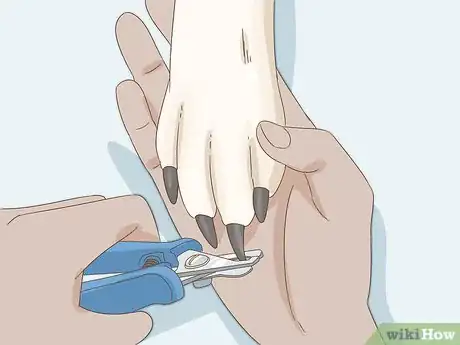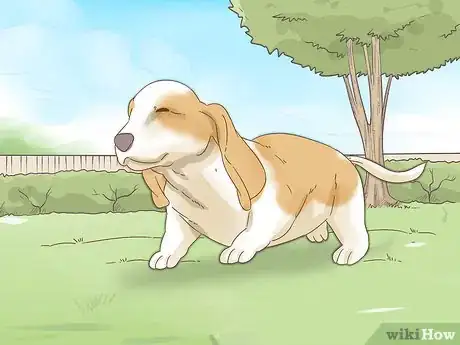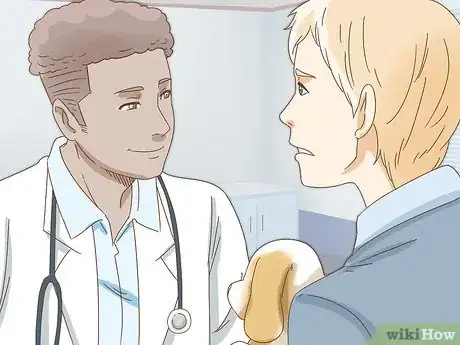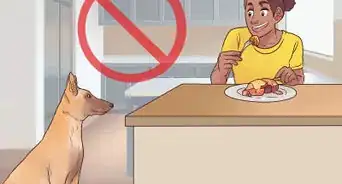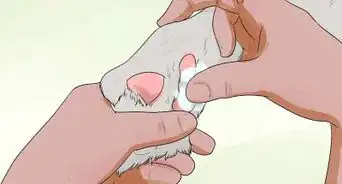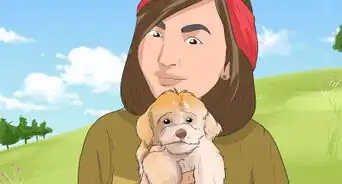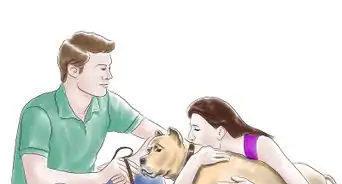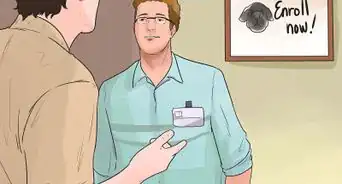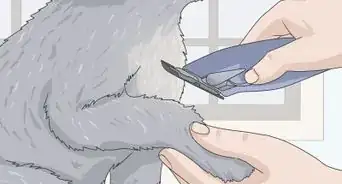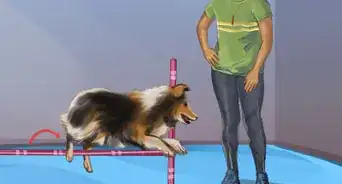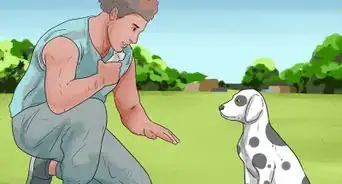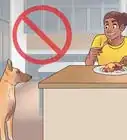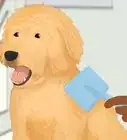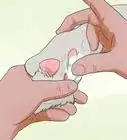This article was co-authored by Brian Bourquin, DVM. Brian Bourquin, better known as “Dr. B” to his clients, is a Veterinarian and the Owner of Boston Veterinary Clinic, a pet health care and veterinary clinic with three locations, South End/Bay Village, the Seaport, and Brookline, Massachusetts. Boston Veterinary Clinic specializes in primary veterinary care, including wellness and preventative care, sick and emergency care, soft-tissue surgery, dentistry. The clinic also provides specialty services in behavior, nutrition, and alternative pain management therapies using acupuncture, and therapeutic laser treatments. Boston Veterinary Clinic is an AAHA (American Animal Hospital Association) accredited hospital and Boston’s first Fear Free Certified Clinic. Brian has over 19 years of veterinary experience and earned his Doctor of Veterinary Medicine from Cornell University.
There are 8 references cited in this article, which can be found at the bottom of the page.
This article has been viewed 94,387 times.
Because Basset Hounds are highly intelligent they can be very stubborn.[1] However, you can minimize this type of behavior by properly training your Basset starting in the puppy years. For a Basset Hound puppy, potty training and crate training are critical. Additionally, establishing a daily routine and teaching your puppy basic commands will also ensure that your dog grows to be an obedient and faithful companion.
Steps
Potty-training a Basset
-
1Begin training as soon as possible. As soon as you bring your puppy home, you should begin training them. Establish a pattern from the beginning by bringing your outside to see if they need to go potty.[2]
- Unless you are feeding, training, or playing with your Basset, use a baby gate to confine your puppy to a small section of the house, like the laundry room, for the first few days. This will enable you to supervise and monitor your puppy to see when your puppy needs to use the restroom.
- Signs that a puppy needs to potty are sniffing the floor, circling while sniffing the floor, and/or whining.[3]
-
2Take your puppy outside every half hour. Because puppies do not have full control of their bladders yet, taking your puppy outside frequently to use the restroom is very important. Taking them outside every half hour to go potty when they are 8 to 12 weeks old will begin to establish the boundaries for urinating and defecating. Once your puppy has gone potty outside, reward the correct behavior with praise and treats.[4]
- Also, take your puppy outside after naps, meals, and after play time to use the restroom.
Advertisement -
3Crate your Basset when they are unsupervised. Dogs are unlikely to soil the areas where they sleep, like their crates. A crate will teach your puppy to control their bladder and bowels. However, keeping your puppy in their crate for too long will increase the likelihood that they will have an accident in their crate. Therefore, only keep your puppy in their crate for short periods of time, for example, an hour at most.[5]
- If your Basset has an accident while in their crate, take them outside immediately. This will encourage and further solidify the association between eliminating and outside. Make sure to clean the area with an odor neutralizer to prevent your puppy from eliminating in the same spot again.
Crate-training a Basset
-
1Purchase a crate. When purchasing the crate, make sure it is not too big. If the crate is too big, your puppy will still be able to eliminate in one corner and sleep in another. However, make sure the crate is not too small, as well. Your puppy should be able to lie, stand, and move around comfortably in their crate.[6]
- Alternatively, you can purchase a crate that is appropriate for your Basset’s expected full-grown size. Use a divider to make the crate smaller, and adjust the divider as your puppy grows. Many crates come with dividers.[7]
-
2Make the crate comfortable. Place a towel or blanket, toys, and treats inside your puppy’s crate. This will entice your puppy to explore the crate on their own. Once your puppy goes inside the crate on their own, reward them with praise and treats. At this point, do not shut the crate’s door right away. You want your puppy to have a positive association with their crate.[8]
- Choose a word or phrase to say when your Basset enters the crate like, “Crate time,” “Go to your room,” or “Nap time.”
- If you bought your puppy from a breeder who lives nearby, try dropping off a towel or blanket at the breeder’s place a few days before picking up your puppy. This way the litter can sleep on the blanket and leave their collective scent. Place this towel in your puppy’s crate to comfort your puppy.[9]
-
3Crate your puppy for small amount of times. Once your puppy has no qualms about going into their crate on their own, select an appropriate time to enclose your puppy. An appropriate time to enclose your puppy is after they have eaten and eliminated outside. After you close the door, stay with your puppy and give them a new toy.[10]
- If your puppy begins to cry, talk to them and reassure them by saying, “That’s a good boy (or girl). It’s ok, I’m here.”
- Leave the puppy in the crate for only ten minutes. Slowly work your way up to longer periods of time.
-
4Place the crate in your room at night. This way, your puppy will be comforted by your scent and will hopefully fall asleep more easily. Set your alarm for three hours so you can wake up to take your puppy outside to use the restroom. By setting an alarm, you will be able to take your puppy out of their crate before they begin to whine or cry. Therefore, you will not be rewarding bad behavior.[11]
- Unless you know that your puppy needs to use the restroom or is hungry, do not take your puppy out of their crate when they whine or cry.
Providing Basic Training
-
1Expose your Basset to varying situations. In the first year of having your new puppy, expose them to unfamiliar dogs, people, and environments. Introduce them to people of varying ages, i.e., adults and children, and to both men and women in non-threatening environments.
- To expose your puppy to new environments and other dogs, take them to the park, for walks, and/or place them in a puppy kindergarten class.
- Keep in mind that the first 18 weeks of your puppy’s life is the best time to socialize them. This is the period when they will be most open to new experiences. Take advantage of this window to raise a confident, well-adjusted adult dog.
-
2Establish a daily routine. Show your puppy where their bed, toys, and food and water bowls are. Establish a routine for when it’s time to eat, play, use the restroom, go to bed, and wake up. This will provide the much-needed structure and security to your puppy’s life.[12]
- For example, wake your puppy up at an established time in the morning, let them outside to use the restroom, and give your puppy their morning meal. Make sure your puppy eats and goes potty before bedtime, and have their bedtime at a certain time, as well.
-
3Teach your puppy basic commands. Begin teaching your puppy commands like “No” and “Good boy.” Once your puppy begins to understand these commands, begin to teach them more complex commands like sit, stay, and come. You can either teach them the more advanced commands yourself, or sign your puppy up for an obedience class.[13]
- Find an obedience class at your local pet store, or ask your veterinarian for recommendations.
Grooming Your Basset
-
1Inspect their ears. Bassets have long ears that can harbor dampness and debris. Therefore, you will need to inspect your Basset’s ears regularly to avoid infections. Acclimate your puppy to having their ears inspected by practicing flipping their ears over for inspection.[14]
- Reward your puppy with praise and treats for allowing you to inspect their ears.
-
2Check their nails. Basset’s nails tend to grow fast. Therefore, you will need to trim your puppy’s nails to prevent them from becoming too long. Your dog’s nails should be trimmed when they are just about to touch the ground when your puppy walks.[15]
- Acclimate your Basset to having their nails clipped by handling their feet when they are still young. Rub your hand over their legs and paws, and gently press each individual toe. Reward your puppy with praise and treats for allowing you to touch their paws and toes.
-
3Exercise your puppy regularly. Bassets are very laid back, but they have a tendency to be lazy. Consequently, Bassets also have a tendency to become overweight and obese. Starting with their puppy years, provide your Basset with physical and mental exercise to prevent obesity.[16]
- Take your Basset puppy outside for self-directed, off-leash play. Allow them to roam around, sniff, and dig.
- Teaching your Basset commands and tricks will stimulate their mind and provide them with the mental exercise that they need.
-
4Consult your veterinarian. It is crucial to take your new Basset hound for an initial checkup as well as annual exams. They will need to be vaccinated, dewormed, and receive medication to protect them from heartworm. You should also discuss spaying/neutering with your veterinarian.
- Your veterinarian will be able to recommend the best training methods for your Basset Hound. Also, ask your veterinarian about the appropriate activities that will enable you to fulfill your dog’s physical and mental exercise needs.
- You can also ask your veterinarian for tips on how to thoroughly inspect your dog’s ears and keep them clean.
Expert Q&A
-
QuestionBasset Hounds: What's Good About 'Em? What's Bad About 'Em?
 Pippa Elliott, MRCVSDr. Elliott, BVMS, MRCVS is a veterinarian with over 30 years of experience in veterinary surgery and companion animal practice. She graduated from the University of Glasgow in 1987 with a degree in veterinary medicine and surgery. She has worked at the same animal clinic in her hometown for over 20 years.
Pippa Elliott, MRCVSDr. Elliott, BVMS, MRCVS is a veterinarian with over 30 years of experience in veterinary surgery and companion animal practice. She graduated from the University of Glasgow in 1987 with a degree in veterinary medicine and surgery. She has worked at the same animal clinic in her hometown for over 20 years.
Veterinarian The best thing about Basset Hounds is undoubtedly their awesome character. They are lovable characters that will return your affection in spadefuls. However, the worst aspect is their health, with a whole range of potential disorders ranging from glaucoma to hip dysplasia, bloat to disc disease.
The best thing about Basset Hounds is undoubtedly their awesome character. They are lovable characters that will return your affection in spadefuls. However, the worst aspect is their health, with a whole range of potential disorders ranging from glaucoma to hip dysplasia, bloat to disc disease. -
QuestionAre Basset Hounds good pets?
 Pippa Elliott, MRCVSDr. Elliott, BVMS, MRCVS is a veterinarian with over 30 years of experience in veterinary surgery and companion animal practice. She graduated from the University of Glasgow in 1987 with a degree in veterinary medicine and surgery. She has worked at the same animal clinic in her hometown for over 20 years.
Pippa Elliott, MRCVSDr. Elliott, BVMS, MRCVS is a veterinarian with over 30 years of experience in veterinary surgery and companion animal practice. She graduated from the University of Glasgow in 1987 with a degree in veterinary medicine and surgery. She has worked at the same animal clinic in her hometown for over 20 years.
Veterinarian Bassett Hounds have a placid nature and make great pets for moderately active people. They have a reputation for being laid-back, which means they cope well around kids (but like any dog, should be supervised with children).
Bassett Hounds have a placid nature and make great pets for moderately active people. They have a reputation for being laid-back, which means they cope well around kids (but like any dog, should be supervised with children). -
QuestionHow do you train a stubborn Basset Hound?
 Pippa Elliott, MRCVSDr. Elliott, BVMS, MRCVS is a veterinarian with over 30 years of experience in veterinary surgery and companion animal practice. She graduated from the University of Glasgow in 1987 with a degree in veterinary medicine and surgery. She has worked at the same animal clinic in her hometown for over 20 years.
Pippa Elliott, MRCVSDr. Elliott, BVMS, MRCVS is a veterinarian with over 30 years of experience in veterinary surgery and companion animal practice. She graduated from the University of Glasgow in 1987 with a degree in veterinary medicine and surgery. She has worked at the same animal clinic in her hometown for over 20 years.
Veterinarian A Bassett Hound will learn when you persist and use reward-based methods. Try to make training sessions fun, and just keep at it with daily training sessions and lots of repetition and praise.
A Bassett Hound will learn when you persist and use reward-based methods. Try to make training sessions fun, and just keep at it with daily training sessions and lots of repetition and praise.
References
- ↑ http://www.akc.org/dog-breeds/basset-hound/care/
- ↑ https://www.petcarerx.com/article/how-to-potty-train-basset-hounds/452
- ↑ https://www.cuteness.com/blog/content/signs-that-a-dog-has-to-go-potty
- ↑ https://www.petcarerx.com/article/how-to-potty-train-basset-hounds/452
- ↑ https://www.petcarerx.com/article/how-to-potty-train-basset-hounds/452
- ↑ http://www.brood-va.org/cratetraining.htm
- ↑ http://www.akc.org/content/dog-training/articles/how-to-crate-train-a-puppy/
- ↑ http://www.brood-va.org/cratetraining.htm
- ↑ http://www.brood-va.org/cratetraining.htm
- ↑ http://www.brood-va.org/cratetraining.htm
- ↑ http://www.brood-va.org/cratetraining.htm
- ↑ http://www.yourpurebredpuppy.com/training/articles/puppy-training-schedule.html
- ↑ http://www.yourpurebredpuppy.com/training/articles/puppy-training-schedule.html
- ↑ http://www.aspca.org/pet-care/dog-care/dog-grooming-tips
- ↑ http://www.aspca.org/pet-care/dog-care/dog-grooming-tips
- ↑ http://www.akc.org/dog-breeds/basset-hound/care/
- ↑ Brian Bourquin, DVM. Veterinarian. Expert Interview. 20 December 2019.
- ↑ Brian Bourquin, DVM. Veterinarian. Expert Interview. 20 December 2019.
About This Article
To raise a Basset hound, you’ll need to establish a daily routine and teach it basic commands as early as possible. This is because Basset hounds are very intelligent, and they can be very stubborn. In the first year of having your Basset hound puppy, try to take it to as many different places as you can, which will help the dog be more comfortable around unfamiliar people and situations. Each day, try to follow the same routine for when it’s time to eat, play, use the restroom, go to bed, and wake up. This structure will help your dog feel secure, which can minimize problem behaviors. For tips from our Veterinary co-author on potty-training and crate-training your Basset hound, read on!
